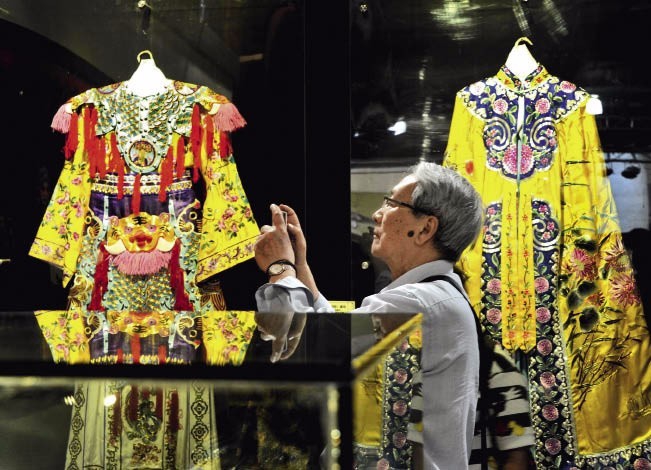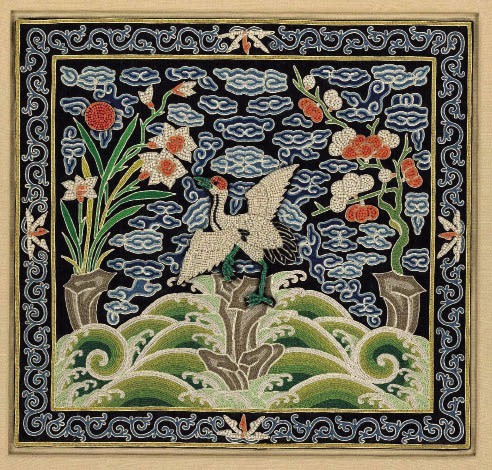
An art archive exhibition of the four main role types portrayed in Peking Opera.
To the layman, they may only see actors wearing colorful and dazzling costumes moving back and forth across the stage, but behind every “outfit” there is much detailed work that goes into making them. Color matching or pattern designs, the making adheres to symbolist principles of Chinese operatic art, all of which are also imbued with the essence of Chinese traditional culture.
Costumes of Luxury
Peking Opera has been called the quintessence of Chinese culture because it embodies the essence of Chinese opera culture. From the music and dance of the Han Dynasty (206 BC - AD 220), performing arts in the Tang Dynasty (618-907), then to the Southern Opera during the Song Dynasty (960-1279), and the Kunqu Opera in the Ming and Qing dynasties (1368-1911), all provided the needed elements for the birth and formation of Peking Opera. The formation of this art is a process of absorbing various elements of other arts. The costumes of Peking Opera also reflect the cultural diversity of different areas in the process.
Although Peking Opera was formed in the Qing Dynasty, the costumes used in plays were made based on the clothing style of the Ming Dynasty. The costumes also absorbed characteristics of clothing styles from the Song, Yuan, and Qing dynasties. Based on the various styles of clothing, modifications were made to the costumes to meet the needs of the singing and dancing movements of actors. The biggest characteristic of Peking Opera costumes is their strong compatibility with no distinction to season or dynasty. The set of clothing is fixed, regardless of the season or the interpretation of the character played in different dynasties. Only in regard to the identity of the character are there strict distinctions.
The making of Peking Opera costumes is a complex and comprehensive art and process which has integrated various cultural and artistic elements, such as costume design, fine arts, embroidery, and mythology among others. It also combines various techniques, such as modeling, printing, embroidery, cutting, and sewing, forming a unique and systematic handicraft technique. In 2006, production techniques of Peking Opera costumes were included in the national intangible cultural heritage list.
Peking Opera costumes are unique in every aspect. The materials selected are elegant high-grade silk products, the designs are very dignified, colors are very bright, and they portray exquisite, meticulous workmanship. The various and vivid images embroidered on the costumes exhibit rich expression. The costumes have really become an inseparable part of the stage performance of Peking Opera, further enhancing the beauty of the already outstanding performance of the artists.
Each traditional costume of Peking Opera has its own unique pattern, most of which are hand-embroidered with silk thread of various colors including silver and gold. The art of embroidery is the most important aspect of craftsmanship used in making Peking Opera costumes. During the process, various traditional embroidery techniques are used as different roles or outfits require a specific technique. When combined together, the techniques cooperate to create superb artistic beauty.
Because the whole process is done by hand, the time it takes to embroider an ordinary garment is about two months. If, on the other hand, it is a court robe or officials’ clothing with large areas of embroidery patterns, the production time will take even longer and requires the assistance of other artisans in completing the task. To become an outstanding embroiderer takes many years of hard work, learning just how to move the needle and apply colors in the exact way to make an exceptional piece of work. Due to the uniqueness of embroidered clothes, some famous actors and actresses choose to have their clothes custom-made, usually costing them a fine price, making it a true luxury.
If we say that half the brilliance of a wonderful theatrical performance is the result of the performance and singing skills of the actors and actresses, then the delicate and colorful costumes make up the other half of the world created on the stage.

Buzi, a square embroidered design, usually adorned on the front and back of an official robe.
Distinct Features of Each Costume
An ancient Chinese proverb says, “The insider knows the ropes, while the outsider just comes along for the ride.” Although the designs of Peking Opera costumes do not change with season or dynasties, the costumes of specific characters are very exquisite and exemplify the identity and status of the characters played, without the slightest thread of variation. “Better it is to wear a worn-out costume than the wrong costume” is the basic principle actors and actresses strive to master. Wearing worn-out clothes may affect the performance, but wearing the inappropriate costume can make the actor the laughing stock of the audience.
Ancient Chinese society was stratified by social classes, and dressing was one of areas that defined them. As seen in the costumes of Peking Opera, the classes and positions of each role are different. The three elements of style, color, and pattern are the soul of Peking Opera costumes.
The “mang robe” or court robe (literally meaning python robe) is a formal dress worn by emperors and generals on formal occasions. Pythons are an animal that is similar to a dragon, and since the dragon robe can only be worn by the real emperor in real life, the python robe was an altered version of that robe design. The fabric of court robes was made with thick silk. Men’s robes are embroidered with various forms of pythons, while women’s robes display stunning patterns of phoenixes. Wearing the python robe in a calm and sedate manner gives the person wearing it a dignified bearing. Python robes are made in many colors including yellow, red, white, black, green, purple, blue, pink, and olive green. Different colors suit different types of characters. For example, the yellow court robe is worn by the emperor, the red court robe is worn by the relatives of royalty or important officials, and the light olive court robe is worn by some elderly people.
The palace dress is the daily attire worn by women of nobility. Although not as formal or solemn as the court robe, its exquisite beauty makes it far exceed the court robe. Embroidered with dozens of ribbons, several layers of silk, together with white sleeves, it is quite a feast for the eyes to see actresses dancing in this robe. The difference between the palace dress and female court robe is that the latter has a jade belt worn around the waist, giving it a more solemn and formal appearance.
The official robe is the formal robe worn by civil officers. It is similar in style with the court robe and is outfitted with a jade belt wrapped around the waist. Where it differs from the court robe is that it is not decorated with so much ornate embroidery. It only has embroidered patterns on the front and back areas. Clothes worn by officers are not made in yellow. They come in red, purple, blue, and black colors. Red is both eye-catching and festive and is usually worn by those who pass the Imperial Examination with high scores or were requested to be the son-in-law of the emperor. The purple official robe is worn by officers of higher ranks, the blue official robe is worn by officers of lower ranks, and the lowest ranking officials usually wear black robes, which include officers in charge of watching the city gates and managing prisons.
The costumes worn by military generals are called “kao” or the coat of plates, which is a kind of armor. It is divided into two plates, one in front and one behind. There are patterns of armor on them, but are worn loosely fitted on the body, making the costume more decorative in nature. During a Peking Opera play, the costume instills the characters standing still with a majestic and stately spirit, while also facilitating them to do exaggerated dance movements. On the back of each “kao,” triangular “coat of plate flags” are inserted, increasing the majestic and heroic posture of a military general. At the same, they reveal that the character is in battle.
The costume worn most widely by ordinary roles of both genders in Peking Opera as casual clothes is called the “xuezi.” It is made in various colors. For example, those who wear a green xuezi robe are mostly callous and pampered young men of affluent parents or heroic figures; those who wear light yellow xuezi robes are lower-class elderly people; those who wear black xuezi robes with a large white collar are upright poor people, and those who wear blue with a large white collar are literati. The black colored xuezi robe is most commonly worn by female characters. Roles which wear black apparel are one of the most important female roles in Peking Opera and have a demure and peaceful temperament. They usually represent a loyal and kind character who has a strong sense of right and wrong.
Another notable feature of Peking Opera costumes is shown on the cuffs that are decorated with long white pieces of silk. They look like rippling water when shaken, and so have been called “water sleeves.” Waving the sleeves is a kind of artistic technique that distinguishes it from the prototypical life. It can extend and enlarge the hand gestures of the characters during their performance, helping actors and actresses express their thoughts and feelings, and create many beautiful dancing gestures.
A Treasurehouse of Peking Opera Costumes
The Bay Tourist Area in Shanghai is home to a very distinct exhibition hall called Bao Wanrong’s Museum of Peking Opera Costumes. Its founder Bao Wanrong (1928-2017) was a Peking Opera performing artist as well as a Peking Opera costume design collector. Bao was fond of Peking Opera since childhood, and at the age of 15 became a formal student of the famous Peking Opera master Xun Huisheng. Later he learned at the feet of the Peking Opera divas Huang Guiqiu and Wang Yaoqing, learning more than 100 classic opera dramas. As time went on, he gradually formed his own artistic style.
When not busy performing operas, being so familiar with the plays as he was and good at painting, Bao designed and made costumes with the help of his teacher Huang Guiqiu and his mother Gu Yunyu. Many actors at that time had him design their performing costumes, and his innovative designs received the praise of many celebrities in the field of Peking Opera.
Beginning in the 1970s, Bao began to focus on collecting, research, and sewing of Peking Opera costumes, and made great progress. He made many improvements and innovations to Peking Opera costumes, and a line of exquisite opera costumes. Among the collection of costumes at the museum today, there is a gold embroidered court robe Bao valued the most. He worked with a master dressmaker and spent a total of three years to finish it. The single robe consumed as much as tens of thousands gold threads. Today it is the “treasure of the museum.”
Bao Wanrong’s Museum of Peking Opera Costumes displays several hundred types of various costumes, such as the court robe, palace dress, coat of plates, and other costumes worn in Peking Opera by the various roles types of the sheng (male), dan (females), jing (painted-face males), and chou (clown). Some were worn by famous Peking Opera masters in his day like Mei Lanfang and Xun Huisheng.
The magnificent costumes of Peking Opera not only exhibit to the world classical beauty but are also endued with traditional Chinese culture. Throughout the long process which made Peking Opera what it is today, the costumes have gradually become an inseparable element of the whole performance. The perfection of costume art has made an important contribution to the art of Peking Opera.